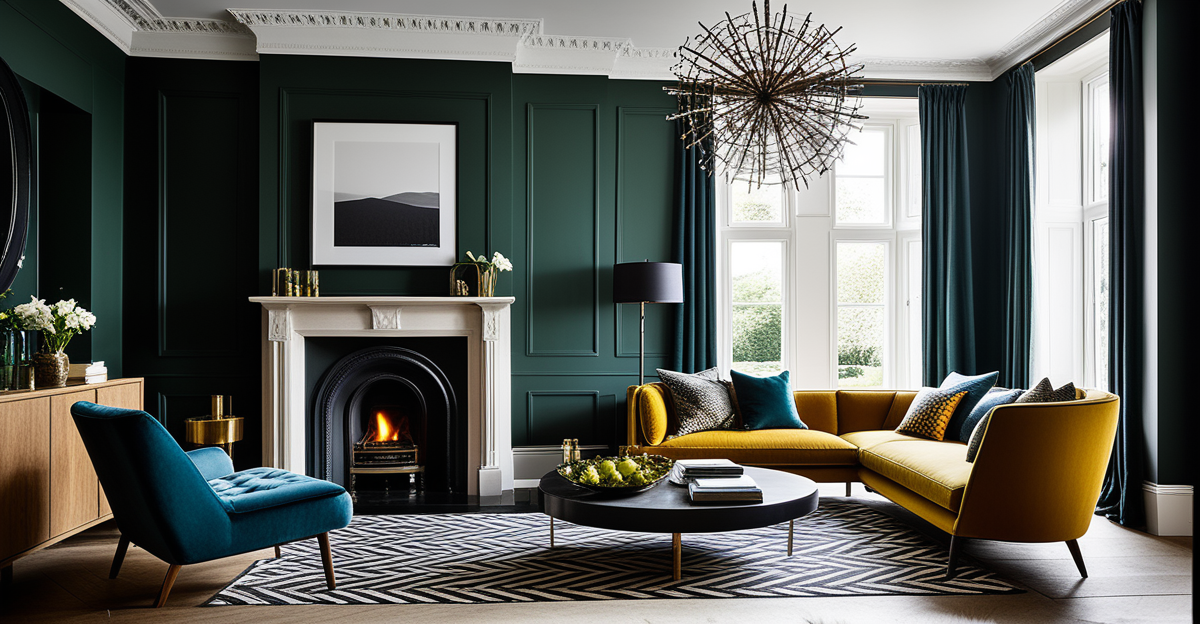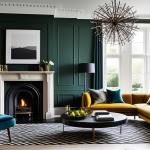Overview of 2023 Color Trends in UK Interiors
The 2023 color trends in the UK are primarily shaped by regional preferences, seasonal changes, and expert forecasts in interior design. A key influence on this year’s palette is the desire for colors that evoke comfort and tranquility, reflecting a shift towards more natural and grounded living spaces. It’s essential to comprehend these regional and seasonal influences, as they directly impact how colors are chosen and applied in homes across the country. Color psychology plays a pivotal role, with contemporary interiors embracing hues that foster a sense of well-being and balance.
Experts predict a resurgence of colors that mirror the natural environment, such as earthy tones and warm neutrals, which not only provide a soothing backdrop but also add depth and warmth to any space. These trends reveal the UK’s home décor will favor versatile and timeless options, aligning with the broader global emphasis on sustainability and organic living. Understanding and integrating these evolving trends can empower homeowners and decorators to create harmonious and enduring interior designs for 2023.
Have you seen this : What Are the Essential Elements of a Cozy UK Home Environment?
Top Color Trends for UK Interiors
In 2023, UK interiors embrace vibrant yet thoughtful color choices, reflecting not just aesthetic preferences but also emotional well-being. This year, warm neutrals are taking center stage, offering a soothing backdrop that complements both modern and traditional styles. Shades like taupe and warm beige are popular, providing a calming influence in living spaces. These hues integrate seamlessly with various textures, helping create a cozy and inviting atmosphere.
Earthy tones remain a steadfast choice, embodying the natural shift seen in contemporary design philosophies. These colors, such as olive green and terracotta, are revered for their grounding qualities. They work beautifully in kitchens and living rooms, embodying a timeless connection to nature. Pairing these hues with rustic wood accents or metallic fixtures can enhance their warmth and appeal, establishing an organic yet chic aesthetic.
Also read : What are creative ways to use lighting in UK home interiors?
Not to be overshadowed, bold accent colors are making statements across UK homes. Deep navy, rich burgundy, and vibrant teal are equally bold and sophisticated. They are best suited for spaces where a splash of personality is warranted, such as feature walls or accent pieces. When balanced with softer elements, like neutral furnishings or patterned textiles, these colors can create a dynamic visual contrast that invigorates interior settings.
Finally, soft pastels bring a delicate and versatile charm, capturing an important segment of the UK market. Pastel pinks, blues, and lilacs are trending in bedrooms and bathrooms, offering a light, airy feel. They can add dimension and freshness without overwhelming the space, especially when harmonized with muted neutrals or gentle patterns. Using pastels as subtle highlights within a broader palette allows for adaptability and a continuous renewal of the space’s ambiance.
Seasonal Influences on Color Choices
The seasonal color trends play a significant role in shaping UK interiors, as consumer preferences shift with the changing seasons. Throughout the year, different palettes come to the forefront, reflecting the varying moods and atmospheres desired by homeowners. In spring, light and fresh tones, such as pastel greens and yellows, become popular, capturing the essence of renewal and growth. In contrast, autumn often invites warmer hues like deep oranges and browns, echoing the natural transition of the environment.
Understanding color psychology is crucial when considering the impact of seasons on interior themes. Each season brings its own emotional and psychological connotations. For instance, winter might inspire cozy and warm settings using rich, dark colors, whereas summer encourages the use of bright and cheerful shades like blues and whites to create breezy, open spaces.
For UK consumers, staying attuned to these seasonal palettes is essential. It allows for a home atmosphere that is both aesthetically pleasing and emotionally resonant. To facilitate smooth transitions between seasons, homeowners can introduce small changes, like swapping out textiles or accessories, to reflect the seasonal mood without overhauling the entire space. Accessorizing with seasonal elements ensures that homes remain fresh and in tune with the year’s cycle, offering continuous renewal and revitalization.
Incorporating Color Trends into Home Design
Incorporating the latest color trends into your home design can invigorate your living space, aligning it with contemporary styles and personal taste. Embracing these trends involves thoughtful consideration of color integration and strategic interior design tips. Whether it’s through paint, accessories, or furniture, understanding how to meld these elements can transform any area.
Choosing the Right Paint
Selecting the proper paint is crucial for integrating trending colors efficiently. Different types of paint and finishes can dramatically affect the final look. Specialist paint finishes like matte or eggshell add texture to warm neutrals, enriching their inherent calming effect. Experts often recommend high-quality brands due to their vast range of hues and lasting coverage. Preparing a room for painting involves cleaning walls, repairing any damages, and testing color samples in varying light to ensure that the chosen shade achieves the desired ambiance.
Color Combinations
Combining colors effectively can elevate any design, making spaces both harmonious and dynamic. Consider color pairings that enhance trending hues: warm neutrals pair gracefully with bold accents, such as deep navy, creating a striking yet balanced effect. Visual examples include pairing vibrant teal with muted greys for a contemporary edge. Techniques like using contrasting colors can create focal points, drawing attention to architectural features or favored pieces of decor, ensuring a cohesive and polished interior.
Accessorizing with Color
Accessories offer an accessible route to adopting 2023’s color trends without significant overhauls. Introducing decor items like cushions, throws, and curtains can complement existing spaces. Popular accessories in the UK market align with the current palette, providing a vast selection to choose from. Textiles bring warmth and texture, while artwork imbues personality, helping to signal color integration seamlessly. Furniture pieces in trending shades can provide anchors in a room, around which other elements revolve, showcasing your stylistic preferences subtly yet effectively.
Expert Opinions on Color Trends
The insights of interior design experts shape the dynamic landscape of UK interiors, providing invaluable guidance on the latest color trends. Prominent professionals emphasize the significance of understanding the 2023 color trends, reflecting a shift towards colors that evoke comfort and tranquility. This year’s UK interiors prioritize hues that foster a sense of balance, aligning with a broader global emphasis on sustainability and organic living.
Renowned experts predict a strong presence of warm neutrals and earthy tones, praising their ability to create inviting and grounded spaces. For interior design enthusiasts, incorporating these shades can enhance both aesthetic appeal and emotional comfort. Hues like taupe and terracotta, revered for their timeless allure, are highlighted as versatile choices that complement diverse design styles.
Professional insights further suggest the strategic use of bold accent colors, such as deep navy and vibrant teal, to introduce personality into spaces. These expert recommendations highlight the benefits of pairing such bold tones with softer elements, achieving a dynamic but harmonious interior. By tuning into expert opinions, homeowners can make informed decisions that reflect contemporary design philosophies and achieve a sophisticated aesthetic.
Listening to voices of authority in interior design not only directs consumer choices but also ensures that homes are styled in a manner that aligns with both personal taste and wider design movements. Engaging with expert advice offers a valuable perspective, bridging the gap between trend analysis and practical application.







